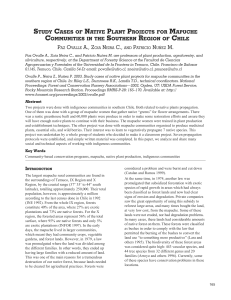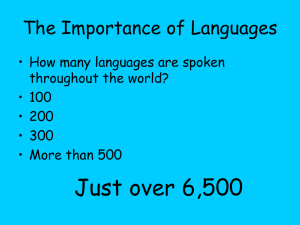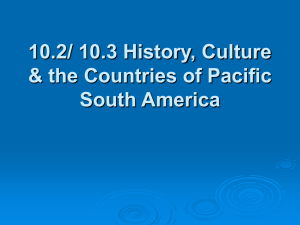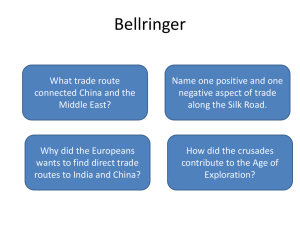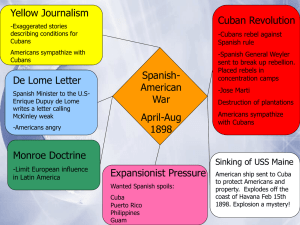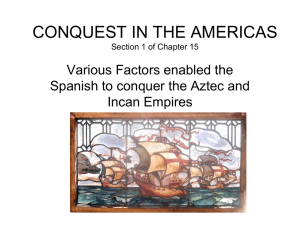Mapuche - Native Studies Resources
advertisement
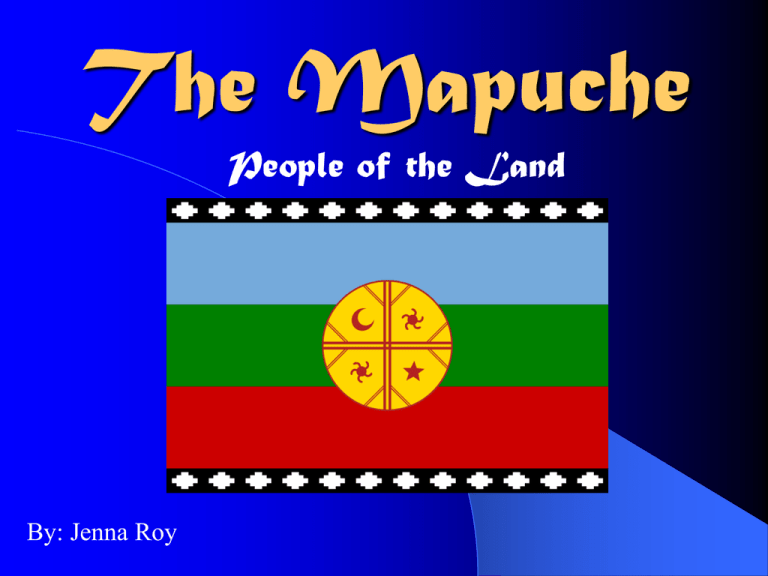
The Mapuche People of the Land By: Jenna Roy Culture & Geography (Pre-contact) The Mapuche are an indigenous culture that originated from the area known as the Southern Cone of South America. They are one of the three surviving tribes of the ancient Araucanian group of natives. The name Mapuche means “people of the land”. Their exact origin is not clear, but it is suggested that they lived mainly within Chile and parts of Argentina. Chile has a wide variety of climate conditions. The east is relatively dry and mountainous, while southern Chile is cool and rainy year round. The Mapuche population, before contact with the Spanish, was approximately 2million. Housing & Family Mapuche housing, called rucas, were very basic with thatched roofs and dirt floors. They were built to provide shelter for one family and were originally placed far from other rucas. Families would settle in a region that provided territory for gathering, agriculture and grazing for the animals. Several related families would gather and live together in the same region. Polygamy was not uncommon, and if the man could afford it, he would take several brides. The man is considered head of the family, but the women are just as economically independent. Women garden and usually posses their own livestock, which can be sold under their consent. Beliefs The Mapuche religion is closely lined to the land and environment. They believe in the existence of a divine family that includes, Old God, Young God, and their two wives. The Machi, the spiritual leader of the community, is the one who is able to communicate with the divine ones. The divine ones have unlimited powers and are usually invisible. The Mapuche are also polytheistic and believe in a number of gods. The gods are categorized into three groupings; major, minor, inferior. Pillan, a minor god, is the god of thunder and volcanoes. Today, the Mapuche religion often mixes ideas of Christianity and their traditional religion. Myths and legends play a major role in the Mapuche culture. The link below provides a popular Mapuche myth. <object width="425" height="344"><param name="movie" value="http://www.youtube.com/v/fIGMu-ws-CM&hl=en"></param><embed src="http://www.youtube.com/v/fIGMu-ws-CM&hl=en" type="application/xshockwave-flash" width="425" height="344"></embed></object> Food The Mapuche were knowledgeable about methods for agriculture, fruit gathering, fishing, hunting, and acquired tools for these methods. The area of Arauco, where it is suspected they might have lived, was by the sea. This provided vast amounts of fish and edible seaweed. Rivers and lakes also provided the Mapuche with an abundance of fish. As for hunting, the Mapuche used domesticated dogs (kiltros) and traps set to catch small animals and birds. They also hunted guanacos and huemul deer. The culture used the slash and burn method. This consisted of clearing a piece of woodland, usually by burning, to sow the seeds. Their basic foods included pallares beans, peppers, potatoes and other vegetables. Although towards the south they had began to develop their agriculture under the influence of the Incas. Here they were able to incorporate corn (maize) into their diet. The pewen nut was an important food for the Mapuche, since it was used to make the flour that was the basis of their diet. Also, they were able to domesticate and breed guanacos and llamas and in the north, minor cattle. A llama Tools & Technology The Mapuche everyday utensils were constructed out of wood, but they were able to create tools out of stone as well. They created ornate masks, sculptures, pipes, grinding tools, cutting tools, and musical instruments. Pottery A Mapuche mask An example of a Mapuche sculpture. This particular one was most likely used as a funeral marker. Government & Trade Relations Within the social structure of the Mapuche culture, the chief or “Lonko” is responsible for his family and community. He or she is head of the group of authorities that are responsible for the destiny of the community. This group included the Machi (spiritual guide or doctor), the Ngenpin (the master of ceremony), the Werrken (the messenger), and the Nidol (the instructor of laws). The Machi, almost always women, had extensive knowledge about herbal medicines. It was said that she could predict the weather, interpret dreams, and ward off evil spirits. The rest of the group were responsible for upholding legal judgments passed by the Ad-mapu and all were greatly respected within their communities. During times of warfare, the Mapuche would unite in larger groupings and elect a “Toqui”, who was responsible and in charge of the army. The Mapuche did not associate much with other indigenous cultures. They would not accept any foreign cultural ideas or domination. They were the only indigenous group to withstand and resist the Incan Empire’s attempts to conquer them. Therefore, the Mapuche communities traded mostly amongst themselves. They usually traded llama furs, textiles, and various vegetables and meats with one another. European Contact When the Spanish first arrived in Mapuche territory in 1536, the Mapuche welcomed them. Only when the Spanish came back in 1541 with intentions of conquering them, did the Mapuche change their views of the Spanish. Spain was trying to expand the boundaries of their colonies. They invaded Mapuche territory, raped women, pillaged the communities, and enslaved many of them. The Mapuche society had no concept of slavery, and therefore did not understand becoming slaves to the Spanish. These events are what started a fierce resistance from the Mapuche peoples and lasted for 350 years. It became known as the Araurcanian War. The Mapuche were able to resist the Spanish, in inferior numbers most of the time, because of their great battle tactics. Unlike other indigenous tribes, the Mapuche were innovative and used new military tactics and weapons. They incorporated horses, armor, and artillery cannons. The Mapuche warriors were known to be extremely courageous and ferocious in battle. Trade/Economic Impact The 350 years of war were not only just filled with hostility and violence but often allowed for substantial trade between the two cultures. The Mapuche would trade llama wools, various vegetables, and ornate weavings with the Spanish. In return they were granted horses, and metal utensils. The trade with the Spanish allowed for the Mapuche to incorporate new weapons and horses in to their battles, therefore making them a force to be reckoned with. It further improved their chances of fighting against the Spanish and other enemies. Treaty of Quillin After a century of the arrival of the Spanish, the Mapuche forced them to sign the Treaty of Quillin. By signing the treaty, the Spanish acknowledged their failure to defeat the Mapuche nation and recognized the independence of the people. The treaty also agreed that the Bio-Bio river was the border and that the Spanish would retreat to the North of the river. The Mapuche in return would release Spanish prisoners of war and allow missionaries to continue with their work. Both the Spanish and Mapuche agreed not to violate the settled borders. However, the Spanish did not live up to their side of the agreement and kept kidnapping the natives, enslaving them, and pillaging their communities. Spain’s actions is what maintained the permanent state of war. Results of Contact Contact with Europeans had both advantages and disadvantages. When Spain attempted to conquer the Mapuche, it resulted in much bloodshed and violence. It produced a raging war that continued for years. Contact with the Europeans resulted in widespread starvation and diseases. As a result, the Mapuche’s population dramatically dropped and both their herding and agricultural traditions were disrupted. When the Mapuche were finally defeated in 1885 by Chilean and Argentinean armies, many were either slaughtered or forced from their homes to live in small rural communities in the city. As a result, many suffered severely from poverty. Contact with Europeans in some ways benefited the Mapuche culture. It united the people together and thus made it harder for the Spanish to conquer. It also allowed for them to posses new technologies and improve their culture. Present Day Today, the Mapuche still live in parts of Chile and Argentina. There is approximately 900,000 living in the two countries. In Chile, the Mapuche make up about 10% of the population but their population is decreasing. Despite the assimilation efforts from Chile, the Mapuche have been able to preserve their traditional language (Mapu-dugun), their religion, and their agricultural methods. However, many still live on the reservations or have migrated to cities in search of better economic opportunities. Around 40% of the Mapuche live in Chile’s capital, Santiago. Treatment towards the Mapuche culture has improved very little. The government in Chile still consistently refuse to promote and protect the rights of their indigenous groups. The education system in Chile ignores and doesn’t teach students about the Mapuche culture and therefore makes it difficult for Mapuche children to maintain their cultural identity. As a result, the Mapu-dugun ( Mapuche language) is quickly dying out. Also, there is much racism towards them, and many stereotypes made on their culture including being lazy and alcoholics. Today, their main source of income comes from agriculture, cattle and grains. Land Claims Like many other indigenous cultures around the world, the Mapuche have had to endure being forced from their land and placed on reserves. They feel that they should have the right to get back the land that was once theirs. Chile exports vast amounts of lumber to the U.S. and almost all of it comes from the land that the Mapuche claim is rightly theirs. Mapuche peoples protesting in the streets to get back land that used to belong to them. Also, Argentina has its share of land claims from the Mapuche. A recent example is the case involving Mapuche against Benetton in Patagonia. Dozens of Mapuche have gathered on more than 534 acres of disputed land, claiming that historically and legally it belongs to them. Lucas Millan, a Mapuche native, said, "For years we remained silent ... we were oppressed, but not any more... The law gives us the right to have this land, but nobody respects it,” (Sagaris p.77). Comparing The Mapuche To the Iroquois The Mapuche and Iroquois cultures had both many similarities and differences. They both had strong religious beliefs and respected and appreciated the land. They both had suffered from contact with the Europeans and still suffer from many social problems today. Both of the cultures relied on similar foods – mainly hunting animals and growing crops such as maize and other vegetables. The Iroquois were more advanced in their knowledge of agriculture. The Mapuche used the slash and burn method, while the Iroquois had developed crop rotation. Another difference was that the Iroquois had a much more advanced form of government. The six tribes formed a confederacy which many citizens, including Benjamin Franklin, admired. The Iroquois seemed to have developed better relations with the Europeans, and became trading partners with the French and Dutch. Today, both groups have had to endure racism and stereotypes. People of the Iroquois nations have seemed to have been able to adapt better to a more modern way of living. Many of the Mapuche still live in their traditional rucas housing. Canadian and U.S. governments seem to have a better understanding and respect for their native’s than Chile does. In Chile, the Mapuche’s heritage and culture is ignored and not mentioned in any classrooms at school. Bibliography Fairfield Sheila. Peoples & Nations of the Americas. Milwauke: Gareth Stevens Publishing, 1988. Saragis Lake. After the First Death: A Journey Through Chile, Time, Mind. Toronto: Somerville House, 1996. The Mapuche Nation. June 10th/08. Available: www.mapuchenation.org/english/main/feature/m_nation.htm Mapuche. June 9th/08. Available: http://en.wikipedia.org/wiki/Mapuche The Mapuche Nation. June 11th/08. Available: http://members.aol.com/mapulink3/mapulink-3i/map-nat.html The Mapuche Language. June 12th/08. Available: http://www.xs4all.nl/~rehue/lang/lan002.html The Mapuches. June 12th/08. Available: http://www.cholchol.org/en_mapuche.php
